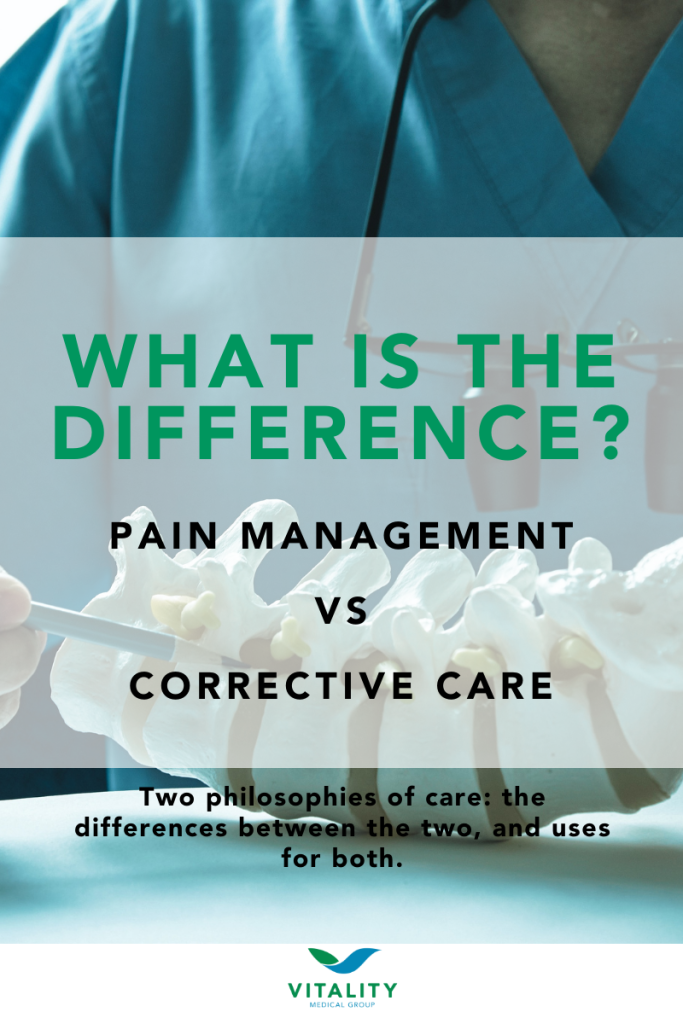
Pain management relieves symptoms temporarily, but since the root cause is not addressed, the symptoms will return as soon as you stop the treatment or therapy you are using (i.e. pain medications, massage, stretching, etc.).
Corrective care utilizes science-based techniques to find the underlying cause of symptoms and correct them.
Most people focus on pain management and then stop treatment, but it is important to remember and understand that pain is only a symptom.
There is always something deeper going on.
Likewise, using painkillers for pain relief only covers up symptoms and does not correct the actual underlying cause. Corrective care finds the underlying cause of the symptom and seeks to eliminate it.
Optimization and Patterns
Human bodies are incredible machines. They want to function at optimal levels and, as such, are exceptional at picking up and repeating patterns. This ability can be incredibly useful or incredibly harmful!
When was the last time you had to consciously spell out your name when signing a receipt or focus typing words on a keyboard? Our body remembers the patterns our hands need to make for these tasks and switches to “autopilot” without direct conscious input. Unfortunately, this is true for all repetitive behaviors. On the flip side bad posture, clenched jaw, sleeping in strange positions to accommodate your kids and pets are examples of bad patterns our bodies adapt to. Your body assumes that is the position you want to set as default. And that’s just the tip of the iceberg.
Mental health can aso create some harmful coping strategies such as people-pleasing and perfectionism that can become solidified in our neural pathways. Traumatic experiences can create a heightened “fight or flight” response that our body will adopt as the standard state of being. Pain isn’t always physical, either. Stress can contribute to the cycle of pain and alter everyday life, physical activity levels, social habits, and mental health. As the downward spiral of pain continues to gain momentum, activities that naturally relieve pain and release “happy chemicals” become restricted while fear and vigilance grow. Essentially, the more these learned neural pathways develop in the body, the more the nervous system “practices” activating a symptom, the easier it becomes to activate it again.
Pain Management Has a Place
All that being said, pain management treatment is still an essential step in healing. Pain has a significant impact on our quality of life, and you should absolutely seek treatment if it’s affecting your life. Temporary relief is better than no relief. In addition, pain management treatments are vital to improved sleep, returning to loved activities, and to maintaining a positive mindset. Once the pain has dissipated or is gone completely, however, you should transition into corrective care. In general, pain management should involve only the initial stages of care and typically should not last more than 4-6 weeks.
Corrective Care is the Path to Health
Corrective care helps keep the pain from coming back and is a strategy used to help you recover from long-established conditions. This can be a long and tedious process, depending on what the internal imbalance is. After all, it will take more than 2-3 treatments to untrain the bad habits and neural pathways. But it is possible.
Specific ways in which corrective care benefits the body are multifaceted, from direct functional impacts to secondary benefits of improved general health and wellbeing. Not only that, but corrective care is restorative and preventive since your body becomes less dependent on previously harmful coping strategies. It can also be anti-inflammatory; by decreasing inflammation, you lower muscular tension, mitigate joint pain and relieve chronic back pain.
Corrective care is vital because it is geared toward restoring your body’s full function rather than simply relieving your pain. A thorough corrective care plan will take into account your family health history, nutrition, sleep, exercise, and environment. It will help you go beyond treating symptoms to actually healing your illness or injury. Your treatment provider will use various science-based techniques to rewire your nervous system. These new neural pathways with pain-relieving benefits, like the ability to participate in physical activity and better sleep, can help boost healing even further.
Like we said, your body wants to be efficient! It just needs to be taught new habits and behaviors. The “unlearning” process can take anywhere from 3 months to several years, depending on the severity and lifespan of the maladaptive pattern. Once you’ve successfully untrained the detrimental habit, you can begin to implement better and healthier ones.



Recent Comments